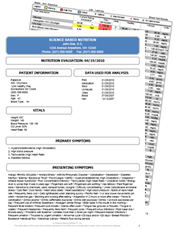Commonly known, Vitamin D’s most important role is maintaining blood levels of calcium and phosphorus which are responsible for skeletal health. However, rrecent clinical and epidemiological studies suggest that vitamin D deficiency may play a role in several conditions unrelated to bone including SAD, prostate cancer, breast cancer, colon cancer, heart disease, hypertension, multiple sclerosis, and type 1 diabetes.1,2,3
Who’s at risk for deficiency?
Sunlight increases vitamin D synthesis in the body when exposed to bare skin. Those who restrict their sunlight and who have a chronic habit of using sunscreen are typically deficient. The use of a sunscreen with SPF as low as 15 reduces the rate of vitamin D production by 99.9%.1 Living in an area with a lot of atmospheric pollution, which can block the sun’s ultraviolet rays, also appears to increase the risk of vitamin D deficiency.1
Strict vegetarians, alcoholics, those with dark skin and people with liver or kidney disease are also at high risk for Vitamin D deficiency. Those with darker skin tones merely need to stay in the sun longer than lighter skinned peoples in order to get the same amount of natural Vitamin D production.
In addition, Vitamin D deficiency is very common in people with digestive disorders (i.e. celiac disease, Crone’s disease, IBS, etc.). One in seven adults has been reported to be deficient in vitamin D.4 In one study, 42% of hospitalized patients under age 65 were reported to be vitamin D deficient.5 In this same study, even though the subjects were eating the currently recommended amounts of Vitamin D, 37% of them were still found to be deficient. Age-related decline in vitamin D status may be due to reduced absorption, transport, or liver metabolism of vitamin D.6
Medications known to cause Vitamin D deficiency: Anticonvulsants; Bile Acid Sequestrants (Cholestyramine, Prevalite, Questran); Cimetidine (histamine blocker); Colestipol; Estrogens (Combined); Flurbiprofen (NSAID); Gabapentin; Heparin; Hydroxychloroquine (Plaquenil); Indapamide; Isoniazid; Mineral Oil; Neomycin; Oral Corticosteroids; Orlistat; Phenobarbital; Sodium Fluoride; Valproic Acid.
How Much To Take?
The best source of vitamin D is bare skin exposure to sunlight with no sunscreen. Naturally, this goes against our sun-phobic society. Sun exposure causes skin cancer, right?
Great food sources of vitamin D include fatty fish such as mackerel, salmon and fish liver oils such as cod liver oil. Trace amounts are also found in egg yolks.
What type of Vitamin D should I take? Vitamin D3, also known as “cholecalciferol”. Avoid “ergocalciferol” or “D2” as this is the synthetic form.
How much Vitamin D should I take? Most critical to the answer of this question is to get tested. How can you possibly know what you need unless you know your individual vitamin D status? You can get this simple blood test through our office. A 25-Hydroxy Vitamin D blood test <32 ng/mL has been shown to impair intestinal calcium absorption and subsequent skeletal density.7 Further studies have shown that Vitamin D blood levels <32 ng/mL are associated with impaired insulin resistance and beta-cell function.7 Optimal levels are 50-90 ng/mL. We feel Vitamin D status is so important to overall health and longevity that we have made it part of our standard panel we order for our patients.
If you do experience SAD, totally avoid the sun or have a higher risk of deficiency as explained on the previous page and want to give Vitamin D a try, 5000IU-10,000IU per day would be sufficient. You cannot get enough Vitamin D from fortified foods and a multi-vitamin. Most of us make about 20,000 units of vitamin D after about 20 minutes of summer sun. This is about 100 times more vitamin D than the government says you need every day.8 If you do spend plenty of time outdoors in the summer, you may reduce this dosage during the summertime.
References:
- Holick MF and Jenkins M, The UV Advantage: The Medical Breakthrough That Shows How to Harness the Power of the Sun for Your Health, New York, NY: ibooks, 2003.
- Endres DB and Rude RK, “Mineral and Bone Metabolism,” Tietz Textbook of Clinical Chemistry, 3rd ed, Burtis CA and Ashwood ER, eds, Philadelphia, PA: WB Saunders, 1999, 1395-457.
- Holick MF, “Vitamin D: A Millenium Perspective,” J Cell Biochem, 2003, 88(2):296-307.
- Chapuy MC, Preziosi P, Maamer M, et al. Prevalence of vitamin D insufficiency in an adult normal population. Osteoporos Int 1997;7:439–43.
- Thomas MK, Lloyd-Jones DM, Thadhani RI, et al. Hypovitaminosis D in medical inpatients. N Engl J Med 1998;338:777–83.
- Harris SS, Dawson-Hughes B, Perrone GA. Plasma 25-hydroxyvitamin D responses of younger and older men to three weeks of supplementation with 1800 IU/day of vitamin D. J Am Coll Nutr 1999;18:470–4.
- Hollis BW, “Circulating 25-Hydroxyvitamin D Levels Indicative of Vitamin D Sufficiency; Implications for Establishing a New Effective Dietary Intake Recommendation for Vitamin D,” J Nutr, 2005, 135(2):317-22.
- www.vitamindcouncil.com

